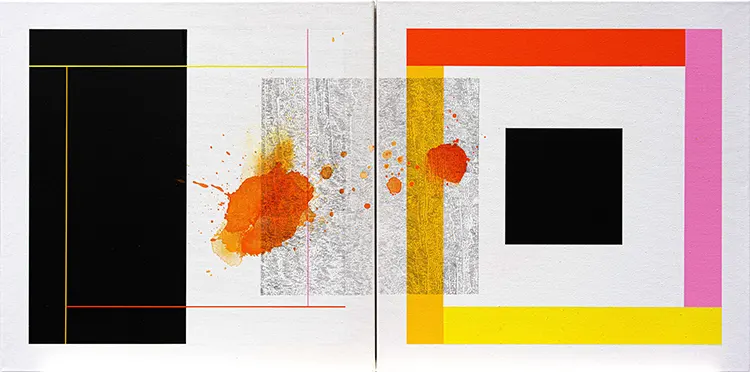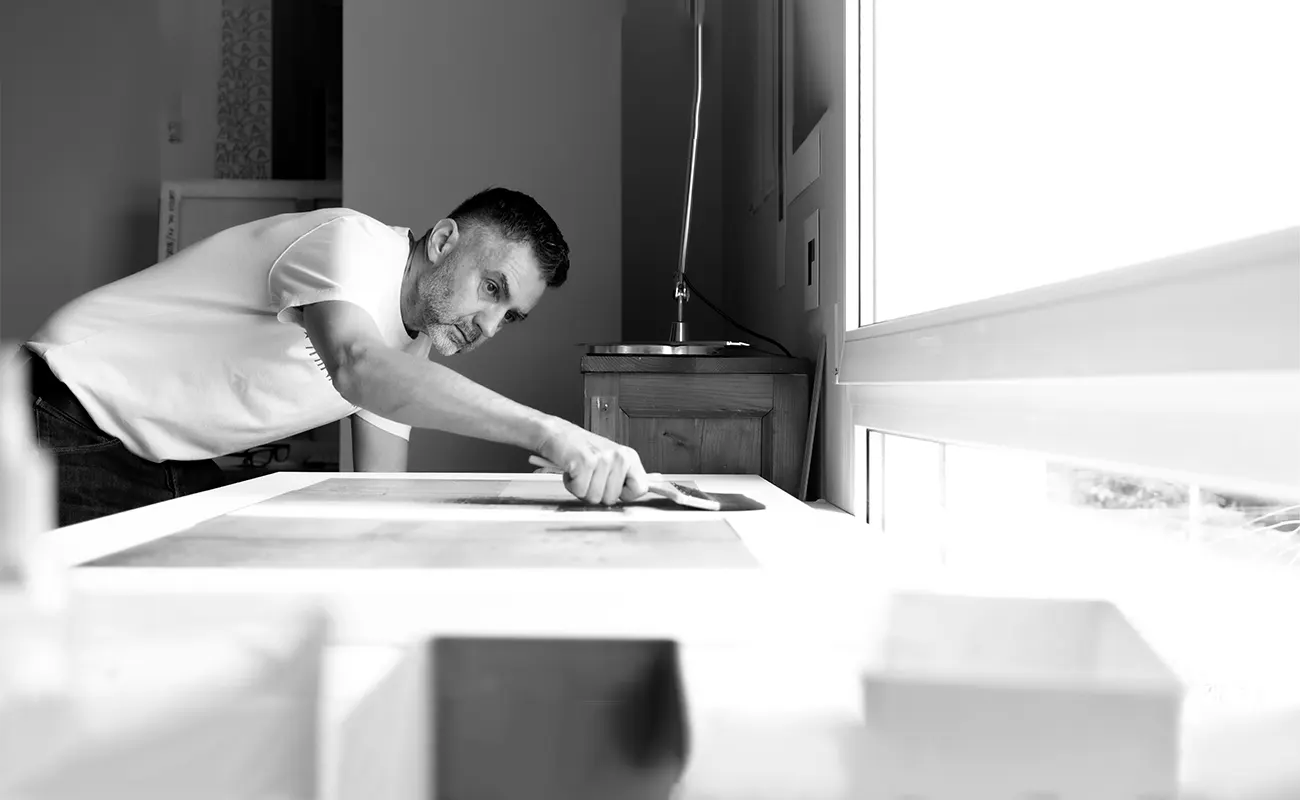“My creative process is akin to jazz. Geometric composition is like the rhythm that organizes the structure of music with precision and rigor.”
Swiss Roots and Geometric Routes: Piccinelli’s Artistic Journey
Originally from the tranquil scenery of Switzerland, Patrick Piccinelli set forth on an enriching academic journey that took him to the distinguished corridors of ECAL (University of Art and Design, Lausanne, Switzerland), a stronghold of artistic brilliance on the global frontier. The respected tradition of flawless typography for which Switzerland is famed, coupled with the deep-seated influences of Swiss graphic design, known for its austere, minimalistic, and refined aesthetics, significantly guided Piccinelli’s artistic path. His palette is firmly rooted in geometric minimalism, a stylistic reverberation reminiscent of the illustrious “Zürich movement.” This era of artistic zeal was pioneered by notable figures such as Max Bill, Richard Paul Lohse, and Verena Loewenberg, luminaries who were the frontrunners of geometric or constructed artistry.
The quintessence of Piccinelli’s Swiss heritage encapsulates a culture of meticulousness and precision that is vibrantly palpable in each stroke and angle of his artistic creations. The minutiae of geometric expressions in Piccinelli’s oeuvre are a testament to a bygone era of structured artistic discipline, embodying the harmonious marriage between strict geometrical constructs and the fluidity of artistic expression. This artistic dialectic not only roots Patrick Piccinelli firmly within a rich tradition of Swiss graphical aesthetics but propels the timeless elegance of geometric minimalism into the contemporary discourse. Through his masterly brush strokes, Piccinelli echoes the reverberations of a significant art movement while concurrently adding a fresh nuance, reflecting both his profound connection to his Swiss origins and his individual ingenuity as a modern artist.
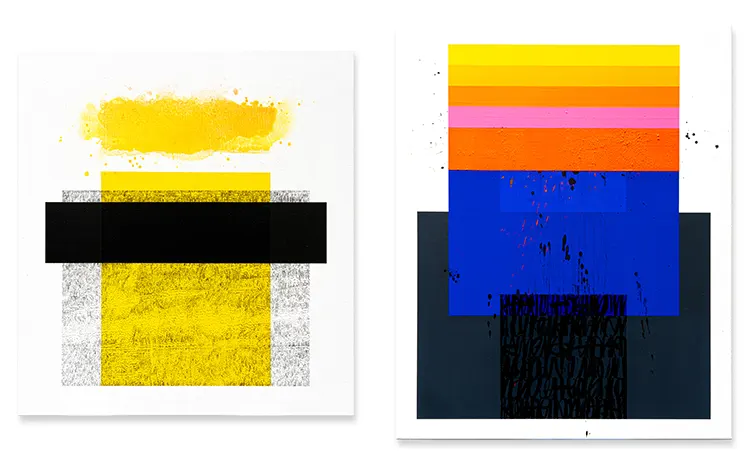
An Early Flame: Igniting the Artistic Spirit within Piccinelli
From a tender age, Patrick Piccinelli showcased a pronounced aptitude for drawing, which markedly surpassed that of a typical child. This early phase bore witness to his growing fondness for the visual arts, which steadily blossomed into his primary conduit for expression and communication. The turning point in Piccinelli’s burgeoning artistic journey arrived at the tender age of 13, an age of exploration and self-discovery. It was during this time that he chanced upon an enthralling documentary centered around the illustrious Robert Motherwell. A particular scene in the documentary captured his imagination profoundly: Motherwell, immersed in the act of crafting a monumental painting upon a vast canvas sprawled across his studio floor, all evolving from a modest sketch titled “Elegy to the Spanish Republic.”
This scene imprinted itself within the fertile realms of Piccinelli’s young imagination, leaving a lasting impression that transcended the ephemeral viewing experience. The documentary, though viewed a singular time, catalyzed a burgeoning aspiration within him. It was then that Patrick Piccinelli’s nascent desire to tread the path of an artist truly crystallized. He envisioned a journey of artistic self-discovery, one that would lead to the evolution of his distinct artistic process. The allure of transforming humble sketches into monumental pieces of art echoed the enchantment Motherwell’s creative process had unveiled. Patrick Piccinelli, with a mind brimming with ideas and a heart fueled by the fervor for visual language, found himself inexorably drawn towards the ceaseless journey of artistic exploration. Through the lens of retrospect, that moment of serendipity watching Robert Motherwell’s creative genius at play, markedly delineated the trajectory of Piccinelli’s artistic endeavor, seeding the inception of a profound quest for artistic expression and a relentless exploration of visual communication.
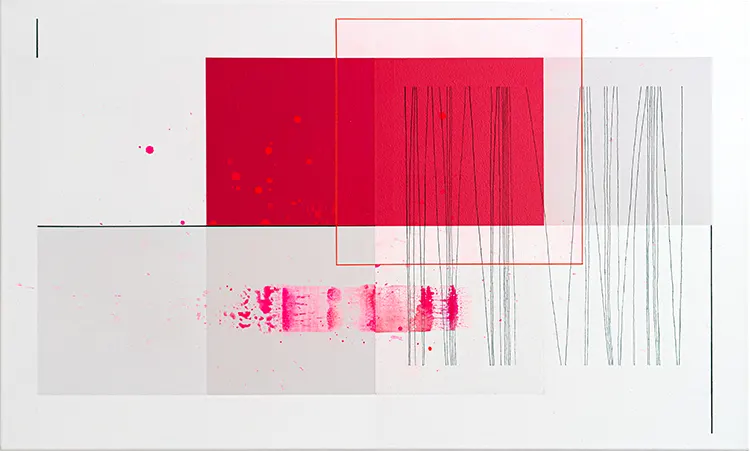
Jazz and Geometry: A Symbiotic Resonance in Piccinelli’s Craft
The artistic ethos of Patrick Piccinelli is deeply entrenched in the aesthetic principles of minimalism, giving rise to meticulously structured, unembellished paintings that resonate with a quiet elegance. Each creation embarked upon by Piccinelli unfurls from a geometric scaffolding, evolving gracefully into a phase of “disruption” once a sense of formal and chromatic gratification has been attained. This transitional phase is marked by spontaneous brush strokes, splashes, and stains, epitomizing the ethos of informal art. It is through this calculated juxtaposition of precise geometry and unscripted deviation, that a visually arresting dialogue between order and disorder is cultivated within each piece.
The quintessence of Piccinelli’s creative pursuit draws a compelling parallel to the nuanced domain of jazz. Here, the geometric foundation in his artwork resonates with the rhythmic precision akin to a meticulously orchestrated musical composition. Meanwhile, the ensuing traces, writings, and splashes channel the unrestrained effusion of improvisational zest reminiscent of a seasoned pianist or saxophonist navigating the ebbs and flows of melodic spontaneity. The dexterity with which Piccinelli maneuvers between the regimented and the unrehearsed, mirrors the fine balance struck by jazz musicians as they traverse between structured rhythm and spontaneous expression.
Such a nuanced amalgamation of order and caprice not only earmarks Piccinelli’s signature style but also beckons an in-depth exploration into the symbiotic relationship between the disciplined and the free-form, casting his oeuvre as a fertile ground for the erudite and the aesthete alike. Through the lens of Patrick Piccinelli’s artistic journey, the observer is invited to traverse the fine line between the geometrically profound and the whimsically impromptu, encapsulating an enduring allure that epitomizes the confluence of discipline and spontaneity in the sphere of visual artistry.
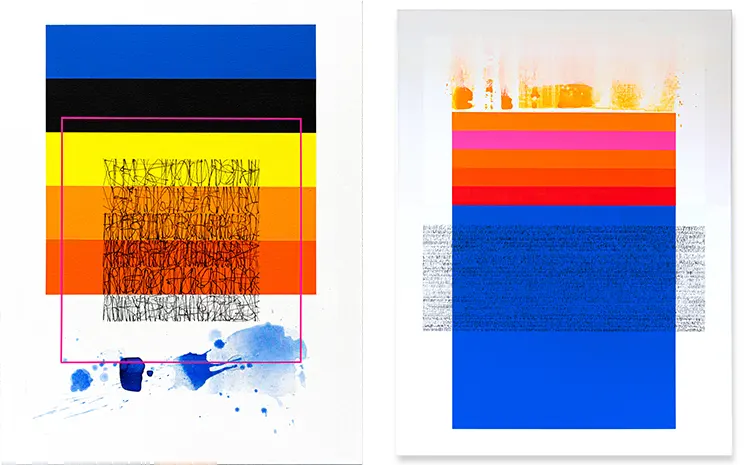
Luminous Creation: The Global Resonance of Piccinelli’s Artistry
Within the serene confines of Patrick Piccinelli’s workspace, luminosity holds a pivotal role, guiding the artist’s brush only under the candid embrace of daylight, thereby eschewing the nocturnal hours for the act of creation. The aesthetics of order too, cast its gentle sway, wherein meticulously arranged brushes await the master’s grasp, laying the groundwork for a sublime interplay of form and color. As the silence of the room is tenderly breached by the rhythmic cadence of music, a particular penchant for the mellifluous tones of jazz, the ambience morphs into a conduit for enhanced focus and unbridled creativity. Piccinelli’s artist endeavor over the undulating course of time has found illustrious companions in the legacies of several venerated artists such as Max Bill, Helmut Federle, Donald Judd, Robert Motherwell, and Pierre Soulages. The resounding notes of jazz, tracing back to the halcyon days of the 70s and meandering through the contemporary beats, seamlessly weave into Piccinelli’s artistic tapestry, crafting a harmonious symphony of visual and auditory allure.
The journey of Piccinelli’s artistry achieved a momentous pinnacle with the acquisition of one of his nuanced creations by a discerning private collector nestled in the vast expanses of the United States. This acquisition not only underscored the growing appreciation for Piccinelli’s oeuvre but held a singularly cherished significance for the artist himself. While the nascent phases of his artistic voyage witnessed a profound affinity among Swiss collectors, the ensuing period heralded the gentle breech of geographical bounds. The essence captured in Piccinelli’s paintings began resonating across the globe, forging newfound homes amidst the discerning echelons of American, Japanese, and Taiwanese art aficionados. This burgeoning global resonance amplifies Piccinelli’s pride and attests to the universal appeal and transcendent nature of his work. Particularly, the aesthetic ethos embedded within Japanese architectural and garden designs, with their revered embodiment and celebration of emptiness, found a poetic echo in Piccinelli’s creations, forging an ethereal bond that the artist holds in high regard and feels profoundly intertwined with.
